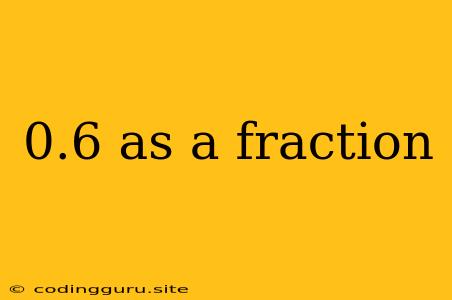Understanding 0.6 as a Fraction
Have you ever wondered how to represent the decimal 0.6 as a fraction? It's a common question that arises in math, especially when dealing with percentages, ratios, and other mathematical concepts. Let's break down the process and explore how to convert 0.6 into its fractional form.
The Basics: Decimals and Fractions
Before diving into the conversion, let's refresh our understanding of decimals and fractions.
- Decimals: Decimals are a way of representing parts of a whole number using a decimal point. The digits after the decimal point indicate the tenths, hundredths, thousandths, and so on. For example, 0.6 represents six-tenths (6/10).
- Fractions: Fractions represent a part of a whole, expressed as a ratio of two numbers, the numerator (top number) and the denominator (bottom number). The denominator tells us how many equal parts the whole is divided into, while the numerator indicates how many of those parts are being considered. For example, 1/2 represents one out of two equal parts.
Converting 0.6 to a Fraction: The Steps
-
Identify the Decimal Place Value: In 0.6, the digit 6 is in the tenths place. This means it represents 6 out of 10 parts.
-
Write the Fraction: Based on the place value, we can write 0.6 as the fraction 6/10.
-
Simplify the Fraction: The fraction 6/10 can be simplified by dividing both the numerator and denominator by their greatest common factor, which is 2. This gives us the simplified fraction 3/5.
Example:
Imagine you have a pizza cut into 10 equal slices. If you eat 6 slices, you have eaten 0.6 of the pizza. This can be represented as the fraction 6/10, which simplifies to 3/5.
Why is it Important to Convert Decimals to Fractions?
There are several reasons why you might need to convert a decimal to a fraction:
- Simplifying Calculations: Working with fractions can sometimes be easier than decimals, especially when multiplying or dividing.
- Visualizing Proportions: Fractions help us visualize parts of a whole more clearly than decimals.
- Understanding Ratios: Fractions are used to represent ratios, which are essential in many fields like science and engineering.
Conclusion
Converting 0.6 to a fraction is a straightforward process that involves understanding the decimal place value and simplifying the resulting fraction. By following these steps, you can confidently represent decimals as fractions and gain a deeper understanding of their relationship.
